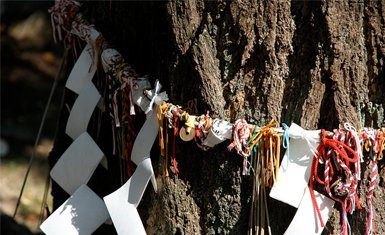Sushi is a Japanese food appreciated all over the world. However, despite their popularity, famous specialty restaurants can be quite pricey. Some do not even offer priced menus, making it difficult for customers to order with confidence.
Much more accessible in terms of price are the “kaiten-sushi” restaurants. Two pieces of sushi are offered for as little as 100 yen. Customers sit at a counter in front of a miniature conveyor belt displaying numerous small plates. Each usually contains two pieces of sushi, and consumers can select their favorites as they pass their view or ask a chef for one in particular. The price is indicated by the color of the plate and, after the meal, the cashier counts the dishes taken to add up the bill.
They also offer other foods on the menu besides sushi, from specialty miso soups to desserts. Most chain restaurants display a computerized menu with images that you can touch to order. Some, but not all, have multilanguage support, in this way it is possible to change the language to the consumer’s preference.
The options are constantly rotating around the table, so if you want something you like, grab it and go. Although it is currently more common for stores to have a conveyor belt, in which, after the customer has placed the order through the screen, the sushi plate arrives mounted on what looks like a train, directly to the table of the order, therefore, there is no need for rotating options.
Kaitenzushi restaurants are found throughout the country. The menu typically features seasonal ingredients in addition to standard sushi like maguro (tuna), shrimp, salmon, and kappamaki (cucumber roll). Many also serve cooked foods, such as miso soup and chawanmushi (steamed egg cream), fried foods, and desserts. In this way, if the client wants to have dinner with someone but the companion does not like sushi, they have the opportunity to order ramen, fried chicken, udon, among others.
When entering the restaurant, you must indicate whether you want to sit at the counter or at a table. In some establishments, a plate with the table number is given to the customer. On each seat, there is a bottle of soy sauce, a container of pickled ginger, a stack of small plates for soy sauce, a box of toothpicks, a small container of green tea powder (or tea bags), cups of tea and a hot water dispenser. Tea is usually self-service. To do this, a little powdered green tea is placed in the cup and hot water is added from the dispenser.
Once seated, you can start grabbing food plates from the conveyor belt or ordering specific dishes directly through the touch panel. Generally, modern establishments have automatic trains parallel to the conveyor belt that deliver orders to customers. In these locations, customers must press a button after they have removed their dishes from the train to return to the kitchen.

As you consume your sushi, stack the empty plates on your table. At the end of the meal, it is notified through the screen that the account is desired and the server will calculate the bill based on the number of empty plates. It may also be calculated automatically, in that case you must take the plate of the table number that was given at the beginning and deliver it to the cash register to pay.
If you are in a city in Japan and want to eat at a kaiten sushi restaurant, the following restaurants are recommended (all have a basic price of approximately 100 yen per plate):
- Genki Sushi 元 気 寿司
- Kappa Sushiか っ ぱ 寿司
- Hamazushiは ま 寿司
- Kura Sushiく ら 寿司
If you come to Japan, it is highly recommended to try the original Japanese sushi. Every sushi dish, such as salmon, shrimp, tuna, salmon or shrimp with melted cheese or mayonnaise, oysters and many other fish, is exquisite, so if you want to enjoy the futuristic experience of eating sushi in Japan, it is recommended to go to a Kaiten Sushi.


